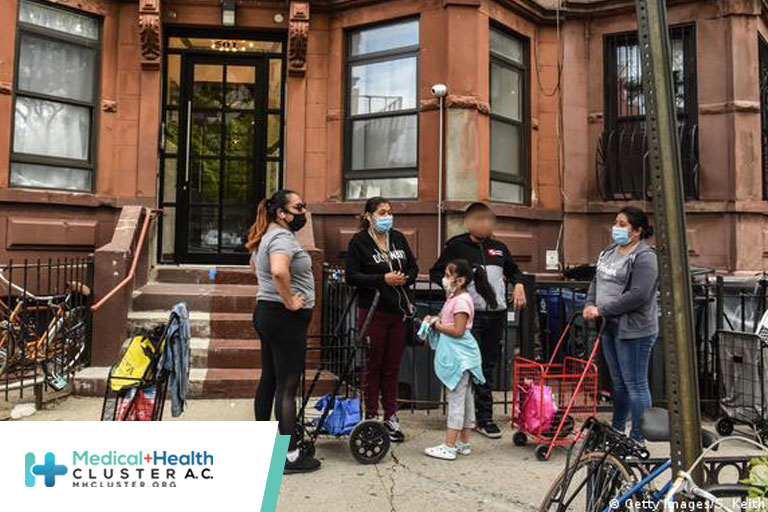En respuesta al anuncio del alcalde Ismael Burgueño Ruiz sobre...
Leer más
County-Level Social Vulnerability and Emergency Department Visits for Firearm Injuries

Summary
What is already known about this topic?
At least 100,000 persons in the United States experience a fatal or nonfatal firearm injury each year.
What is added by this report?
During 2018–2021, among 10 jurisdictions participating in CDC’s Firearm Injury Surveillance Through Emergency Rooms program, counties with higher overall social vulnerability experienced higher proportions of emergency department visits for firearm injuries.
What are the implications for public health practice?
Monitoring firearm injury emergency department visits by county-level social vulnerability can help guide tailored prevention efforts that address inequities in social and structural conditions that contribute to risk for violence, including creating protective community environments, strengthening economic supports, and intervening to reduce harms and prevent future risk.
At least 100,000 persons in the United States experience a fatal or nonfatal firearm injury each year.* CDC examined rates of firearm injury emergency department (ED) visits by community social vulnerability using data from CDC’s Firearm Injury Surveillance Through Emergency Rooms (FASTER) program.† ED visit data, shared with CDC’s National Syndromic Surveillance Program (NSSP)§ during 2018–2021, were analyzed for 647 counties in 10 FASTER-funded jurisdictions.¶ County-level social vulnerability data were obtained from the 2018 Social Vulnerability Index (SVI).** Rates of ED visits for firearm injuries (number of firearm injury ED visits per 100,000 ED visits) were calculated across tertile levels of social vulnerability. Negative binomial regression models were used to estimate rate ratios (RRs) and associated 95% CIs comparing rates of ED visits across social vulnerability levels. During 2018–2021, compared with rates in counties with low overall social vulnerability, the firearm injury ED visit rate was 1.34 times as high in counties with medium social vulnerability and 1.80 times as high in counties with high social vulnerability. Similar patterns were observed for the SVI themes of socioeconomic status and housing type and transportation, but not for the themes of household composition and disability status or racial and ethnic minority status and language proficiency. More timely data†† on firearm injury ED visits by social vulnerability can help identify communities disproportionately experiencing elevated firearm injury rates. States and communities can use the best available evidence to implement comprehensive prevention strategies that address inequities in the social and structural conditions that contribute to risk for violence, including creating protective community environments, strengthening economic supports, and intervening to reduce harms and prevent future risk (e.g., with hospital-based violence intervention programs) (1,2).
In 2021, CDC’s FASTER program was established to provide more timely and comprehensive data on firearm injuries at the state and local levels than were available through traditional data sources. CDC analyzed ED visit data during January 1, 2018–December 31, 2021, for 647 counties in 10 FASTER-funded jurisdictions. Aggregated data were shared through CDC’s NSSP platform (3). The 10 jurisdictions included in this analysis reported data on a minimum of 75% of ED visits occurring within their jurisdictions, including a minimum of 90% of visits from Level 1–3 trauma centers.§§ Initial firearm injury encounters (including those classified as unintentional, intentional self-harm, assault, legal intervention, terrorism, and undetermined intent) were identified using a syndrome definition including diagnosis codes and chief complaint text fields (Supplementary Box, https://stacks.cdc.gov/view/cdc/118752).
Data on county-level social vulnerability were obtained from the 2018 SVI, which uses U.S. Census Bureau American Community Survey 2014–2018 5-year data¶¶ estimates for 15 population-based county-level sociodemographic indicators to form an overall social vulnerability metric, as well as four additional focused metrics representing themes of socioeconomic status, household composition and disability, racial and ethnic minority status and language proficiency, and housing type and transportation. The SVI includes ranked scores ranging from 0–1 applied to 3,142 counties in the United States.
Counties in the 10 FASTER-funded jurisdictions were categorized into tertiles (low, medium, high) of social vulnerability for the overall SVI, the SVI themes, and the individual indicators of each SVI theme, with higher values representing higher levels of social vulnerability. Crude rates of firearm injury ED visits (number of ED visits for firearm injuries per 100,000 ED visits) were calculated for each level of social vulnerability. A total of 647 (99.2%) of 652 counties sharing data with NSSP in the 10 jurisdictions had data on ED visits and the SVI, and were included in the analyses. Negative binomial regression models including fixed effects for jurisdictions were fit to estimate RRs and associated 95% CIs comparing rates among high and medium social vulnerability counties with those in low social vulnerability counties across the overall SVI, separate SVI themes, and individual SVI indicators.*** Regression analyses were conducted using SAS software (version 9.4; SAS Institute). SVI tertiles were included in the models as categorical variables. This activity was reviewed by CDC and was conducted consistent with applicable federal law and CDC policy.†††
During 2018–2021, the overall crude firearm injury ED visit rate among the 10 jurisdictions was 74 per 100,000 ED visits, with low, medium, and high social vulnerability counties experiencing rates of 55, 77, and 92 firearm injury ED visits per 100,000 ED visits, respectively. Compared with counties with low overall social vulnerability, rates of firearm injury ED visits were 1.34 and 1.80 times as high in counties with medium and high overall social vulnerability, respectively (Table). Similar patterns were observed for the SVI theme of socioeconomic status, with rates of firearm injury ED visits higher among counties with medium (RR = 1.27) and high (RR = 1.61) vulnerability compared with counties with low social vulnerability. This pattern was apparent for all four indicators of socioeconomic status, with the most pronounced differences in firearm injury ED visit rates observed when comparing SVI tertiles across the poverty indicator.
For the housing type and transportation theme, rates of firearm injury ED visits were also higher among medium (RR = 1.32) and high (RR = 1.75) social vulnerability counties compared with low social vulnerability counties. This pattern was apparent for two of five indicators constituting the theme: percentage of persons living in group quarters and percentage of households with no vehicle access.
Although ED visit rates were not higher in medium and high social vulnerability counties for the two SVI themes of household composition and disability status and racial and ethnic minority status and language proficiency, among specific indicators for each, rates were higher among counties with higher percentages of single-parent households and persons identifying as a racial or ethnic minority; rates were lower among counties with higher percentages of persons aged ≥65 years.
Discussion
In this multistate report analyzing syndromic surveillance ED data for firearm injuries across FASTER-funded jurisdictions, counties with higher overall social vulnerability experienced higher rates of firearm injury ED visits during 2018–2021. Higher community social vulnerability has been previously associated with higher rates of firearm deaths (4). The findings of this report indicate that social vulnerability is also associated with the percentage of ED visits that are for firearm injuries.
In this analysis, among all ED visits, higher proportions of firearm injury ED visits occurred in low socioeconomic status communities. An index of neighborhood disadvantage, including poverty and unemployment, has been previously associated with higher numbers of firearm injuries (5), and surrounding poverty and higher income inequality have been linked to higher firearm homicide rates (6,7). In the present analysis, rates of firearm injury visits were also associated with additional indicators, including proportion of racial and ethnic minority persons. Current and historical inequities that marginalize some racial and ethnic minority groups in the United States might contribute to elevated rates of firearm injuries in these communities (8). For example, structural racism, in the form of redlining, a discriminatory practice of systematic disinvestment of neighborhoods and denial of service provision (including financial services) to residents of neighborhoods that include substantial numbers of racial and ethnic minority and low-income residents, has been associated with higher rates of firearm injuries in an urban setting (9); evidence indicates that racial residential segregation has also been predictive of racial disparities in firearm-related homicides (10). Patterns of firearm injury visit rates also varied by age, vehicle accessibility, housing density, and single-parent household status. Together with additional context and understanding of historical and structural factors affecting specific communities, these data can help guide tailored prevention efforts and partnerships to reduce inequities in risk for firearm injuries.
The findings in this report are subject to at least five limitations. First, data are limited to 10 U.S. jurisdictions and are not nationally representative. Second, the syndrome definition used in this study to identify firearm injury ED visits does not distinguish the injury intent; the distribution of firearm injuries across levels of social vulnerability might be different for specific intents. In addition, the definition might under- or overestimate ED visits related to firearm injuries because of possible variation in coding practices and reporting of visit-level data across facilities. Third, the number of facilities sharing data with NSSP can vary over time. Potential fluctuations in facility participation were accounted for by calculating a rate indicating the proportion of the total number of ED visits for firearm injuries. However, rates, and thereby, comparisons, across SVI tertiles could be influenced by changes in the denominator or characteristics of the populations usually served by participating facilities. Fourth, the smallest geographic level at which these firearm injury data were available at the time of this report is at the county level, which limits the ability to examine the distribution of firearm injuries across smaller geographic levels (e.g., census tract). Finally, the SVI is based on 5-year estimates during 2014–2018, and ED visits during 2018–2021 were analyzed. The timing of the data and ecological design limit the ability to draw causal conclusions and examine current or historical determinants of firearm injuries.
Timelier ED data can help health departments and clinical and community partners collaboratively identify communities disproportionately experiencing firearm injuries. SVI data can help focus prevention efforts on reducing and addressing the effects of the underlying drivers of inequities using strategies with the best available evidence, including creating protective community environments, strengthening economic supports, and intervening to reduce harms and prevent future risk (e.g., with hospital-based violence intervention programs) (1,2).
Acknowledgments
Jurisdictions participating in CDC’s Firearm Injury Surveillance Through Emergency Rooms (FASTER) program; FASTER team, CDC; National Syndromic Surveillance Program, CDC; Anna Blackstock, Daniel Bowen, Nimi Idaikkadar, Aaron Kite-Powell.
Corresponding author: Miriam E. Van Dyke, mpy4@cdc.gov.
Créditos: Comité científico Covid
Link: https://www.cdc.gov/mmwr/volumes/71/wr/mm7127a1.htm?s_cid=mm7127a1_w&fbclid=IwAR1kqwuliD8wgk61iv6XBelDWHoZmXk1pwWQridYBwNeneGiWsWkfnvZsKg




